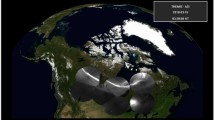Abstract
The dynamics of auroral arcs, observed in the prenoon sector during the 2-h period, has been studied in the context of ionospheric convection. The appearance of an isolated arc, the poleward drift velocity of which pronouncedly exceeded the plasma drift velocity, accompanied the IMF impulse and could result from the Alfvén resonance oscillations of the magnetosphere. Arcs that appeared after the northward turning of the IMF vertical component drifted poleward at a velocity close to the convection velocity. The mechanism of arc generation is related to the flute instability which develops in the region of the large-scale field-aligned current. Flute instability indications are found out in the POLAR satellite data. The study confirms the previously proposed classification criterion for dayside arcs with the source on closed field lines, based on the character of arc drift as compared to convection.
Similar content being viewed by others
References
C. J. Farrugia, P. E. Sandholt, N. C. Maynard, et al., “Pulsating Midmorning Auroral Arcs, Filamentation of a Mixing Region in a Flank Boundary Layer, and ULF Waves Observed during a Polar-Svalbard Conjunction,” J. Geophys. Res. 105(12), 27 531–27 554 (2000).
G. J. Fasel, “Dayside Poleward Moving Auroral Forms: A Statistical Study,” J. Geophys. Res. 100(7), 11 891–11 905 (1995).
I. V. Golovchanskaya and Y. P. Maltsev, “Interchange Instability in the Presence of the Field-Aligned Current: Application to the Auroral Arc Formation,” J. Geophys. Res. 108, 1106 (2003).
W. J. Hughes, “Magnetospheric Ultra-Low-Frequency Waves: A Tutorial with a Historical Perspective,” Geophys. Monogr. Am. Geophys. Union 81, 1–11 (1994).
A. Kozlovsky and J. Kangas, “Motion and Origin of Noon High-Latitude Poleward Moving Auroral Arcs on Closed Magnetic Field Lines,” J. Geophys. Res. 107, 1017 (2002).
A. Kozlovsky, V. Safargaleev, J. Jussila, and A. Koustov, “Pre-Noon High-Latitude Auroral Arcs as a Manifestation of the Interchange Instability,” Ann. Geophys. 21(12), 2303–2314 (2003).
M. R. Lessard, M. K. Hudson, J. C. Samson, and J. R. Wygant, “Simultaneous Satellite and Ground-Based Observations of a Discretely Driven Field Line Resonance,” J. Geophys. Res. 104, 12 361–12 378 (1999).
W. Lotko, A. V. Streltsov, and C. W. Carlson, “Discrete Auroral Arc, Electrostatic Shock and Suprathermal Electrons Powered by Dispersive, Anomalously Resistive Field Line Resonance,” Geophys. Res. Lett. 25(24), 4449–4452 (1998).
W. Lyatsky, R. D. Elphinstone, Q. Pao, and L. L. Cogger, “Field Line Resonance Interference Model for Multiple Auroral Are Generation,” J. Geophys. Res. 104, 263–268 (1999).
B. V. Rezhenov, “A Possible Mechanism for Aurora Formation,” Ann. Geophys. 13(7), 698–703 (1995).
A. J. Ridley, G. Lu, C. R. Clauer, and V. O. Papitashvili, Reply to Comment by M. Lockwood, and S. W. H. Cowley on “A Statistical Study of the Ionospheric Convection Response to Changing Interplanetary Magnetic Field Conditions Using the Assimilative Mapping of Ionospheric Electrodynamics Technique” by A. J. Ridley, G. Lu, C. R. Clauer, and V. O. Papitashvili, J. Geophys. Res. 104, 4393–4396 (1999)
V. V. Safargaleev, A. E. Kozlovsky, S. V. Osipenko, and V. R. Tagirov, “Azimuthal Expansion of High-Latitude Auroral Arcs,” Ann. Geophys. 21(8), 1793–1805 (2003).
V. Safargaleev, T. Sergienko, H. Nilsson, et al., Combined Optical, EISCAT and Magnetic Observations of the Omega Bands/Ps6 Pulsations and an Auroral Torch in the Late Morning Hours: A Case Study,” Ann. Geophys. 23(5) (2005)).
J. C. Samson, T. J. Hughes, F. Creutzberg, et al., “Observations of a Detached, Discrete Arc in Association with Field Line Resonances,” J. Geophys. Res. 96, 15683–15695 (1991).
P. E. Sandholt, C. J. Farrugia, J. Moen, et al., “A Classification of Dayside Auroral Forms and Activities as a Function of Interplanetary Magnetic Field Orientation,” J. Geophys. Res. 103, 23 325–23 345 (1998).
P. E. Sandholt, M. Lockwood, K. S. C. Freeman, et al., “Midday Auroral Breakup Events and Related Energy and Momentum Transfer from the Magnetosheath,” J. Geophys. Res. 95, 1039–1060 (1990).
G. V. Starkov, “Auroral Heights in the Polar Cap,” Geomagn. Aeron. 8(1), 36–41 (1986).
V. M. Vasyliunas, “Mathematical Models of Magnetospheric Convection and Its Coupling to the Ionosphere,” in Particles and Fields in the Magnetosphere, Ed. by B. M. McCormac (Reidel, Dordhecht, 1970), pp. 60–71.
M. A. Volkov and Yu. P. Maltsev, “Flute Instability of the Plasma Sheet Inner Boundary,” Geomagn. Aeron. 26(5), 798–801 (1968).
V. G. Vorobjev, G. Gustafsson, G. V. Starkov, et al., “Dynamics of Day and Night Aurora during Substorms,” Planet. Space Sci. 23(2), 269–283 (1975).
Author information
Authors and Affiliations
Additional information
Original Russian Text © A.E. Kozlovsky, H. Nilsson, V.V. Safargaleev, 2006, published in Geomagnetizm i Aeronomiya, 2006, Vol. 46, No. 4, pp. 501–513.
Rights and permissions
About this article
Cite this article
Kozlovsky, A.E., Nilsson, H. & Safargaleev, V.V. Complex study of the auroral arc dynamics and ionospheric plasma convection in prenoon hours. Geomagn. Aeron. 46, 473–484 (2006). https://doi.org/10.1134/S0016793206040098
Received:
Accepted:
Issue Date:
DOI: https://doi.org/10.1134/S0016793206040098




